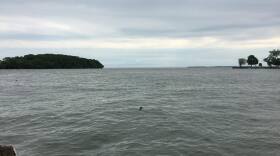Gov. Mike DeWine has released details of his plan to improve water quality in Ohio, starting with preventing toxic algae blooms in Lake Erie. The H2Ohio program will start in the Maumee River watershed near Toledo but he wants to eventually broaden it to rest of the state.
DeWine said agricultural runoff is the biggest contributor to algae blooms, including the massive bloom in August 2014 that left 400,000 people in Toledo without drinkable water.
"Yet Ohio has directed only a fraction of its past spending to the root cause of the problem. The rest of the money has gone to other projects related to drinking water and waste water improvement – very very important things. But they did not reduce the Lake Erie algae blooms," DeWine said.
DeWine said with the H2Ohio program, the state will focus on practices that have been proven to keep phosphorus from running off farms and into water. He said the state will cover start-up costs for farmers on 10 science-based practices for applying fertilizer, building ditches and planting trees and shrubs to keep phosphorus out of water:
- Soil testing
- Variable rate fertilization
- Subsurface nutrient application
- Manure incorporation
- Conservation crop rotation
- Cover crops
- Drainage water management
- Two-stage ditch construction
- Edge-of-field buffers
- Wetlands
And DeWine said farmers will those practices won’t be mandated - for now.
“We don’t believe we’ll have to because we believe our strategy will lead to significant changes within the confines of our current law today," DeWine said. "We do, though, need all farmers to participate at some level because they really are key to our progress.”
DeWine said the state got buy-in from some of the country's largest agribusinesses. And he said the Department of Agriculture, Ohio EPA, the Ohio Department of Natural Resources and the Lake Erie Commission will work together on this. And he said there's a plan to develop an electronic reporting system for the public.
$172 million in the current budget for H2Ohio will also go to create new wetlands, prevent lead contamination in drinking water at day care centers and schools, and fix failing home sewage treatment systems in disadvantaged communities. DeWine said 31% of existing home sewage systems could be failing.
“It’s not just about Lake Erie," DeWine said. "It’s not just about asking our farmers to reduce phosphorus or change farming practices, although it is about both. And it’s not just about increasing the number of wetlands across Ohio. Rather, it’s about all of us working together to meet our shared goals.”
Managing farm runoff has been a major issue for farmers and the state over the last few years. Two months before former Gov. John Kasich left office, he fired Agriculture Director David Daniels in a dispute over an executive order Kasich signed creating tougher rules on fertilizer and nutrient runoff.






